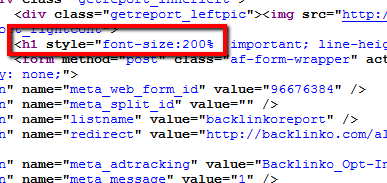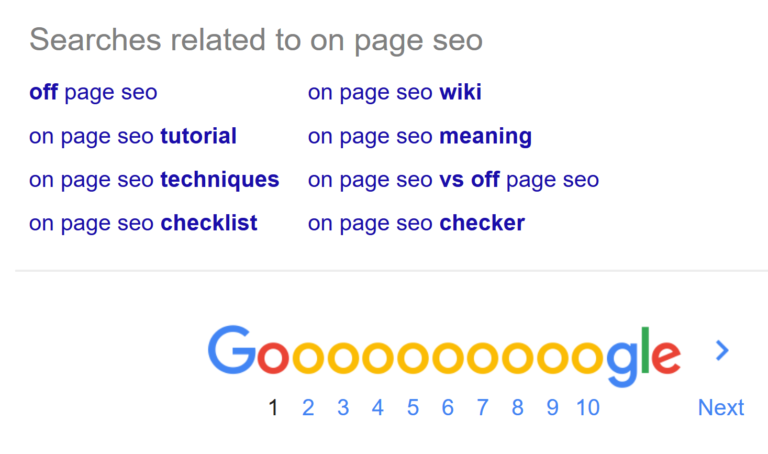Envelop Your Website Post Name within an H1 Tag
The H1 tag is your headline tag” that is “. Most CMS’s (like WordPress) automatically add the H1 tag to your own site post name. If that’s the case, you place.
But this setting is overridden by some topics. Check your website’s code to ensure your name gets the H1 love it deserves. I used to suppose that WordPress hooked my post titles up with H1 tags until I actually looked at my site’s code.
Afterward I understood that WordPress themes sometimes use H1 tags to increase text size. For example, my email opt-in place was previously enveloped in an H1 tag: Worth checking out your site’s code to ensure you have just one H1 tag per page, it’s. And that H1 tag should contain your target keyword.

Wrapping Subheadings in H2 Tags
In at least subheading… include your target keyword and wrap it in an H2 tag.
This undoubtedly won’t break or make your on-page SEO attempts. But my tests have shown me that a dent can be made by rolling your objective keyword in a H2 tag.
Here’s an example of this strategy in action (target key word=”SEO strategy”):

Use SEO-Friendly URLs
Google has said that the first 3-5 words in a URL are given more weight. So make your URLs sweet and short. And always contain your target keyword in your URL. In other words: Avoid nasty URLs: domain.com/p=123 Or URLs: domain.com/8/6/16/cat=SEO/on-page-seo-is-so-amazing-omg-its-the-best
Use Responsive Design
Google started penalizing mobile unfriendly sites in 2015. And they’re likely crack down even more later on. If you prefer to make your website mobile-friendly, I recommend Reactive Design.
I’d be surprised if your website isn’t mobile- friendly yet. But when it'sn’t, possibly the motivator of more search engine traffic will push you to take the leap.
And when you’re going to generate your site mobile-friendly, I STRONGLY recommend design that is responsive. For user experience, it’s perfect in my opinion. It is preferred by plus Google.
Use Internal Links
Internal linking is SO money. Use 2-3 in every post. If you wish to determine a fantastic example of how to internal link on your website, check out Wikipedia.
They add keyword-loaded internal links to each entry: Because they’re Wikipedia clearly, they can get away with 50 internal links per page. I recommend a simpler (and safer) strategy: link to 2-5 senior posts if you print a new one.
Use Social Sharing Buttons
Societal signs may not play an immediate role in ranking your website. But more eyeballs are generated by societal shares on your content.
And the more eyeballs you get, the more likely someone is to link to you personally. So don’t be bashful about putting societal sharing buttons conspicuously on your own site. The truth is, a study by BrightEdge found that outstanding social sharing buttons can increase societal sharing .
Societal signs aren’t an essential part of the Google algorithm. But social shares on sites like Google, Twitter and Facebook may give you an indirect positions boost.
Sprinkle LSI Keywords
LSI key words are synonyms that Google uses to discover a page’s relevancy (and perhaps quality). Sprinkle them into every post.
I do because I normally write EXTREMELY content n’t go nuts about LSI key words.
(Long content increases the odds that you’ll naturally use LSI keywords). But when you want to make 100% certain that you’re using LSI key words, search for the keyword in Google and scroll right down to the “Searches Related to…” area in the bottom of the page: Throw one or two of these into your post.

It is very nice blog to improve my knowledge in digital marketing. Thanks for sharing this awesome blog.
ReplyDeleteDigital Marketing Courses in Chennai | Digital marketing training institute in Chennai | Digital marketing course Chennai
Excellent information with unique content and it is very useful info.
ReplyDeleteDigital Marketing Training Course in Chennai | Digital Marketing Training Course in Anna Nagar | Digital Marketing Training Course in OMR | Digital Marketing Training Course in Porur | Digital Marketing Training Course in Tambaram | Digital Marketing Training Course in Velachery
I'm really happy with your blog because your post is very unique and powerful for new readers...
ReplyDeleteDigital Marketing Training Course in Chennai | Digital Marketing Training Course in Anna Nagar | Digital Marketing Training Course in OMR | Digital Marketing Training Course in Porur | Digital Marketing Training Course in Tambaram | Digital Marketing Training Course in Velachery
"This is a wonderful article, Given so much info in it, These type of articles keeps the users interest in the website, and keep on sharing more ... good luck.
ReplyDeleteDigital Marketing Training Course in Chennai | Digital Marketing Training Course in Anna Nagar | Digital Marketing Training Course in OMR | Digital Marketing Training Course in Porur | Digital Marketing Training Course in Tambaram | Digital Marketing Training Course in Velachery
"